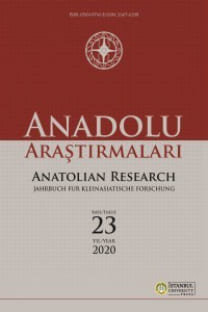Political Relations between the Urartian and Assyrian Kingdoms: A Regional Comparison in Areas of Conflict
Urartu, Assyrian kingdom, Political Relations, Middle Iron Age, East Anatolia
___
Botta, P. E., Flandin, M. E. 1849 Monument de Ninive: découvert et décrit par M.P.E. Botta; mesuré et dessiné par M.E. Flandin Paris, Imprimerie Nationale.Çilingiroğlu, A. 1976-77 "Sargon’un Sekizinci Seferi ve Bazı Öneriler", Anadolu Araştırmaları 4-5: 235-271.
2012 "Ayanis", A. Çilingiroğlu, Z. Mercangöz, G. Polat (ed.), Ege Üniversitesi Arkeoloji Kazıları, İzmir, Ege Üniversitesi: 2-23.
Dezsö, T. 2006"Subria and the Assyrian Empire", Acta Ant. 46: 33-38.
Diakonoff, I. M., Kashkai, S. M. 1981Geographical names according to Urartian texts, Répertoire géographique des textes cunéiformes ; Bd. 9, Wiesbaden, L. Reichert.
Grayson, K. A. 1991Assyrian Rulers of the Early First Millenium B.C. I (1114-859 B.C.): The Royal Inscriptions of Mesopotamia, Toronto, Buffalo, London, University of Toronto.
1996Assyrian Rulers of the Early First Millenium B.C. II (858-745 B.C.): The Royal Inscriptions of Mesopotamia, Assyrian Periods. Vol.3, Toronto, Buffalo, London, University of Toronto.
Hawkins, J. D. 1982"The Neo-Hittite States in Syria and Anatolia", CAH III/1: 372-441.
Kessler, K. 1995"Subria, Urartu and Assur: Topographical Questions around the Tigris Sources", M. Liverani (ed.), Neo-Assyrian Geography, Quaderni di Geografìa Storica, 5., Rome, Università di Roma La Sapienza: 55-67.
Konakçı, E. 2009 "Urartu Krallığı'nın Ekonomik ve Siyasi Yapılanmasında Toplu Nüfus Aktarımları", H. Sağlamtimur, E. Abay, Z. Derin, A. Ü. Erdem, A. Batmaz, F. Dedeoğlu, M. Erdalkıran, M. B. Baştürk, E. Konakçı (ed.), Altan Çilingiroğlu'na Armağan. Yukarı Denizin Kıyısında Urartu Krallığı'na Adanmış Bir Hayat/ Studies in Honour of Altan Çilingiroğlu. A Life Dedicated to Urartu on the Shores of the Upper Sea, İstanbul, Arkeoloji ve Sanat Yayınları: 367-381.
Köroğlu, K. 1998Üçtepe I: Yeni Kazı ve Yüzey Bulguları Işığında Diyarbakır/ Üçtepe ve Çevresinin Yeni Assur Dönemi Tarihi Coğrafyası, Ankara, Türk Tarih Kurumu.
2011"Urartu: Krallık ve Aşiretler / Urartu: The Kingdom and Tribes", K. Köroğlu, E. Konyar (ed.), Urartu: Doğu'da Değişim / Transformation in the East, İstanbul, Y.K.Y.: 12-51.
2015"Conflict and Interaction in the Iron Age: The Origins of Urartian–Assyrian Relations", European Journal of Archaeology 18/1: 111-127.
2016"Archaeological evidence for the provincial system of the Neo-Assyrian empire in Anatolia", J. MacGinnis, D. Wicke, T. Greenfield (ed.), The provincial archaeology of the Assyrian empire, McDonald Institute for Archaeological Research: 309-320.
Kuhrt, A. 2009Eskiçağ'da Yakın Doğu (M.Ö. 3000 - 330), 1 - 2, İstanbul, İş Bankası Yayınları.
Lehmann-Haupt, C. F. 1916"Musasir und der achte Feldzug Sargons II. (714 v. Chr).", Orientalistische Studien Fritz Hommel zum sechzigsten Geburtstag: 119-151.
Levine, L. D. 1977"Sargon's Eighth Campaign", L. D. Levine, T. C. Young, Mountainsand Lowlands: Essays in the Archaeology of Greater Mesopotamia, Malibu, Undena Publications.: 135-151.
Luckenbill, D. D. 1926 Ancient records of Assyria and Babylonia, New York, Greenwood Press.
1927 Ancient Records of Assyria and Babylonia II, Chicago.
Millard, A., Whiting, R. M. 1994 The eponyms of the Assyrian empire 910-612 BC, State Archives of Assyria, [Helsinki], The Neo-Assyrian Text Corpus Project.
Muscarella, O. W. 1986"The Location of Ulhu and Uiše in Sargon II's Eighth Campaign, 714 B. C.", Journal of Field Archaeology 13: 465-475.
Parpola, S., Reade, J. 1987 The correspondence of Sargon II. Part. I, Letters from Assyria and the West, State Archives of Assyria, Helsinki, Helsinki University Press.
Parpola, S., Johns, C. H. W., Tallqvist, K. L. 1970Neo-Assyrian toponyms, Alter Orient und Altes Testament, , Kevelaer,, Butzon & Bercker.
Piepkorn, A. C. 1933 Historical prism inscriptions of Ashurbanipal I, Chicago, University of Chicago Press.
Postgate, J. N. 1995"Assyria: the Home Provinces", M. Liverani (ed.), Neo-Assyrian Geography, Quaderni di Geografia Storica, 5., Roma, Universita di Roma "La Sapienza": 1-17.
Radner, K. 2011"Assyrians and Urartians", S. R. Steadman, G. McMahon (ed.), The Oxford Handbook of Ancient Anatolia, 734-751.
2016"Revolts in the Assyrian Empire: Succession Wars, Rebellions Against a False King and Independence Movements", J. J. Collins, J. G. Manning (ed.), Revolt and Resistance in the Ancient Classical World and the Near East In the Crucible of Empire, Boston, Brill: 41-54.
Radner, K., Schachner, A. 2001"Tuşhan’dan Emedi’ye: Assur Döneminde Yukarı Dicle Havzasıyla İlgili Topografik Sorular", N. Tuna, J. Öztürk, J. Velibeyoğlu, Ilısu ve Karkamış Baraj Gölleri Altında Kalacak Arkeolojik ve Kültür Varlıklarını Kurtarma Projesi 1999 Yılı Çalışmaları/ Salvage Project of the Archaeological Heritage of the Ilısu and Carchemish Dam Reservoirs Activities in 1999, Ankara, 729-752.
Reade, J. E. 1976"Sargon's Campaigns of 720, 716, and 715 B. C.: Evidence from the Sculptures", Journal of Near Eastern Studies 35/2: 95-104.
Rigg, A. H. J. 1942"Sargon's 'Eighth Military Campaign'", Journal of the American Oriental Society 62: 130-138.
Salvini, M. 2006Urartu Tarihi ve Kültürü, İstanbul, Arkeoloji ve Sanat Yayınları.
2008Corpus dei testi Urartei I, I, Roma.
Starr, I. 1990Queries to the Sungod : divination and politics in Sargonid Assyria, State Archives of Assyria, Helsinki, Finland, Helsinki University Press.
Thureau-Dangin, F. 1912"Une relation de la huitième campagne de Sargon", Textes cunéformes du Louvre 3/Paris: Paul Geuthner.
Thureau-Dangin, F., Dunand, M. 1936Til-Barsib, Paris, P. Geuthner.
Wright, E. M. 1943"The Eighth Campaign of Sargon II of Assyria (714 B. C.)", Journal of Near Eastern Studies 2/3: 173-186.
Zimansky, P. 1990"Urartian Geography and Sargon's Eighth Campaign", Journal of Near Eastern Studies 49: 1-21.
- ISSN: 0569-9746
- Yayın Aralığı: 2
- Başlangıç: 1955
- Yayıncı: İstanbul Üniversitesi Edebiyat Fakültesi
Doğu Toros Petroglifleri: Tırşin Yaylası ve Çevresi
Keban Projesi: Ağın Hoşrik Mevki ve Kalecikler Kurtarma Kazılarına Yeni Bir Bakış
“Doğu Anadolu Arkeolojisinin Sorunları ve Çözüm Önerileri Paneli” Üzerine
Şarhöyük MÖ 2. Binyıl Mimarisi Üzerine Ön Gözlemler
Gürgürbaba Tepesi: Alt ve Orta Paleolitik Dönem Buluntu Yerleri, Erciş-Van
İsmail BAYKARA, Berkay DİNÇER, Serkan ŞAHİN
Bottle Shaped Vessels in Anatolia and the Syrian Bottle
